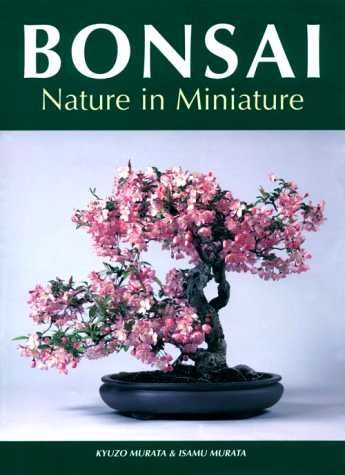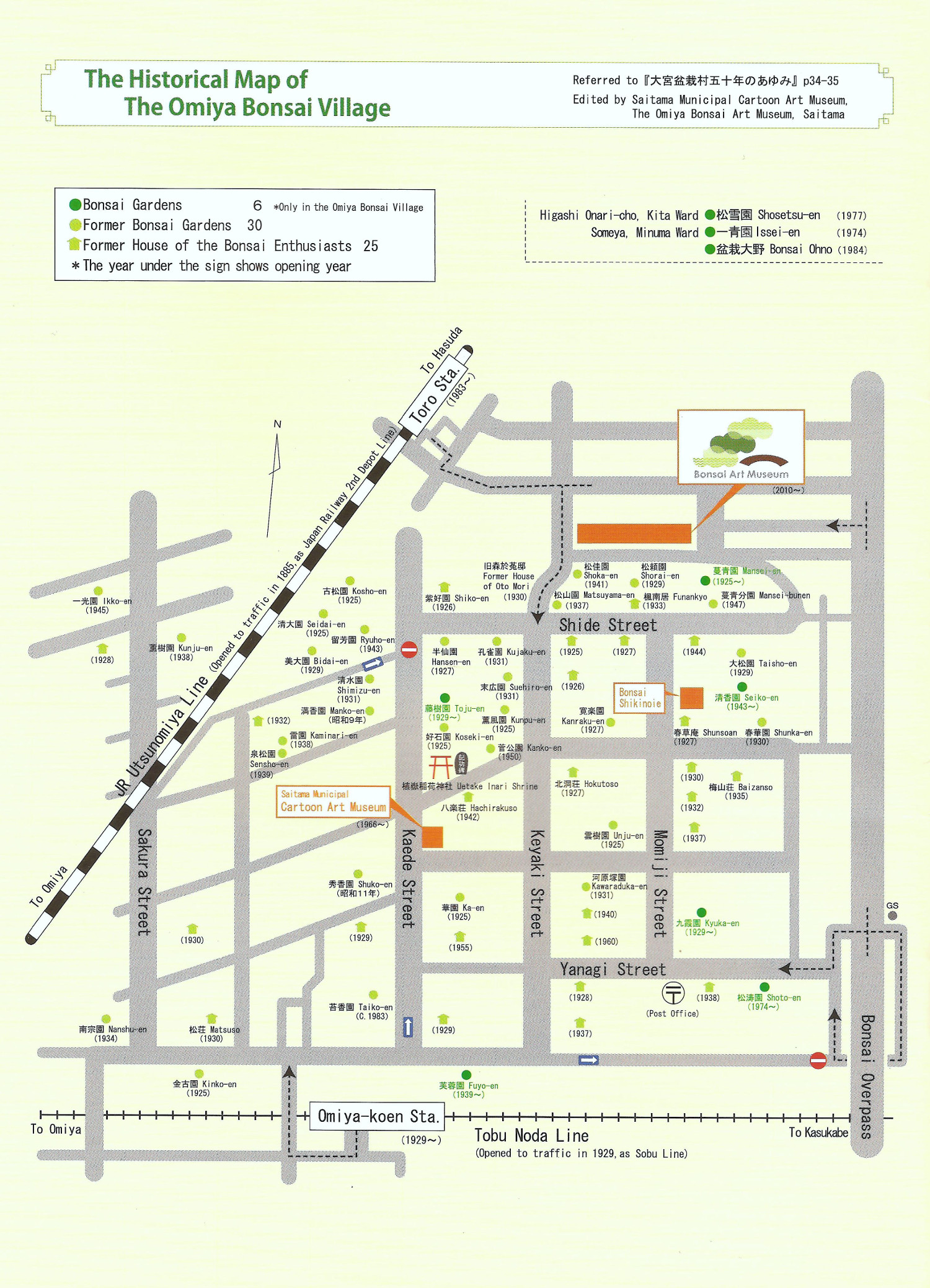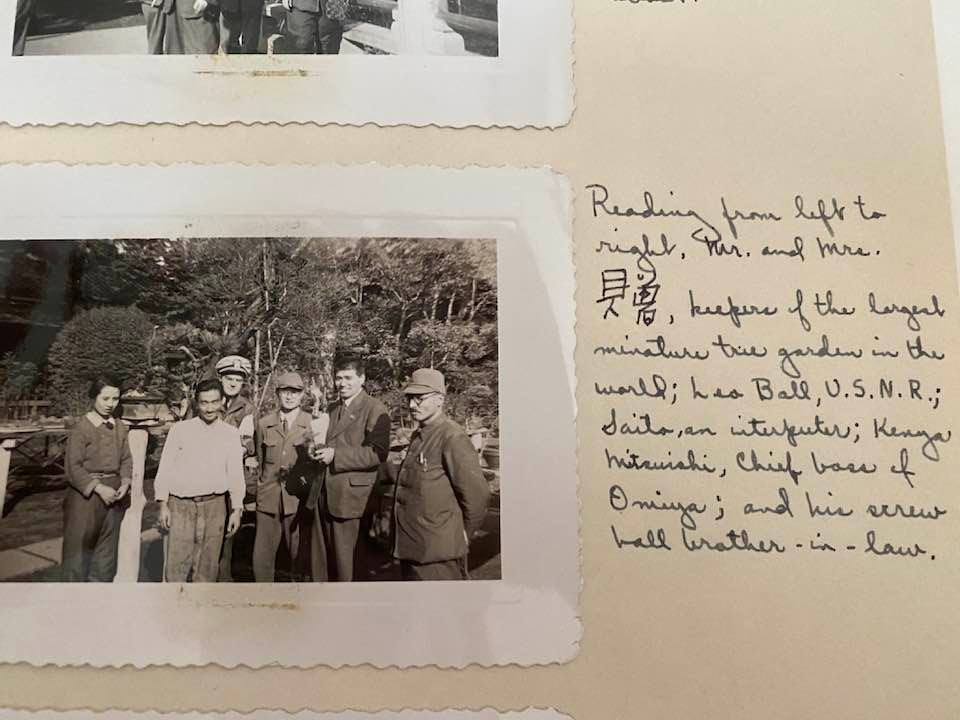1
Murata, Kyuzo Bonsai: Miniature Potted Trees
(Tokyo: Shufunotomo Co., Ltd., 1964), pg. 115; "The Passing Of A Bonsai Master, Kyuzo Murata," International Bonsai,
International Bonsai Arboretum, 1991/No. 4, pg. 41; Busch, Noel F., "The Lilliputian World of the Bonsai",
The Reader's Digest, September 1967, pg. 184. (RJB has a special place in his heart for this 6-page article,
an original copy of which resides in our files.) Busch also wrote the 1962 Simon and Schuster book,
Two Minutes to Noon, about the 1923 Tokyo earthquake which, among many other things, resulted in the
creation of the Bonsai Village at Ōmiya in 1925; Personal e-mail correspondance between Yukio Murata and RJB
on 21 Dec 2004 and 22 Apr 2006;
"Hikawa Shrine (Saitama)"; "Kita Ward"; "About us: Kyukaen,"
http://www.iris.dti.ne.jp/~kyukaen/kyukaen/kyukaen-top-e.htm,
accessed 20 Aug 2001 and re-accessed 18 Dec 2004 with revised URL, which gives 1929 as the establishment date for Kyukaen.
2
Murata, Kyuzo "The Early Days of Ezo Spruce Bonsai," International Bonsai, IBA, 1990/No. 2, pp. 14-17,
pg. 15 with b&w photo of the group planting; Tayson, Dr. Juyne, "Bonsai Personality -- Kyuzo Murata",
International Bonsai Digest Bicentennial Edition (Los Angeles: International Bonsai Digest, 1976), pg. 94; Nozaki,
Shinobu Dwarf Trees (Bonsai) (Tokyo: Sanseido Company, Ltd., 1940), pg. 34; Masakuni Kawasumi's
Bonsai with American Trees, pg. 7; Kawasumi's Bonsai Tools and User's Manual
(1979, seventh edition, 1989), inside front cover and pg. 5. How did Murata come to care for the Imperial
trees -- was it, perhaps, by way of introduction from Kato-san? Until the Meiji period quote from "Shiny blades,"
Bonsai Focus, 132/109, 2/2011 Mar/Apr, pg. 70, originally published in Kinbon magazine and translated by
Peter Warren; "The Passing Of A Bonsai Master, Kyuzo Murata," pg. 41; Personal e-mail correspondance between Yukio Murata and
RJB on 30 Aug 2007; Per a review by Cheryl Owens of the book
The Imperial Bonsai of Japan in the Fall 1977 issue of the Bonsai Journal, American Bonsai Society,
pg. 66, in 1926 there were more than 5,000 bonsai in the possession of the Imperial Palace, compared with about
600 in 1976; Japanese horticulture article per Yukio Murata in personal e-mail correspondance to RJB on 07/24/2007,
which includes the note "But it is highly probable that there is an [older] article before this."
3
"Ōmiya Bonsai Village"; Busch's article, pp. 184-185, which on the former page states "That bonsai growing
survived Japan's dark days during World War II must be credited almost entirely to Murata."; Tayson's article, pg.
13, which states that "only Murata San was allowed to continue as a bonsai entrepreneur, because he was the official
entrusted to care for the Imperial Bonsai Collection."; Nippon Bonsai Association's
Classic Bonsai of Japan
(Tokyo: Kodansha International; 1989), pg. 154; Heffelfinger, George "A Practical Guide to Independent
Bonsai Rambling in Japan," Bonsai Journal, ABS, Vol. 16, No. 2, Summer 1982, pg. 37; Fukumoto, David W.
"Saburo Kato: The Gentle Spirit of International Bonsai and Peace,"
Bonsai Journal, ABS, Vol. 22, No. 4, Winter 1988, pg. 6 states that the Katos at their Ōmiya nursery were
criticized for taking care of bonsai during the war; Personal e-mail correspondance between Yukio Murata and RJB on
21 Dec 2004; "About us: Kyukaen,"
http://www.iris.dti.ne.jp/~kyukaen/kyukaen/kyukaen-top-e.htm, accessed 20 Aug 2001 and re-accessed 18 Dec 2004
with revised URL.
4
Busch's article, pp. 185-186. Where and when was Mercier's article[s] published? Our researches
have not yet tracked it down; Kempinski, Robert "Trip to Japan," Bonsai Journal, ABS, Vol. 39, No. 1, Spring
2004, pg. 26, which also states that the current Imperial collection contains over 1,000 trees; "About us: Kyukaen,"
http://www.iris.dti.ne.jp/~kyukaen/kyukaen/kyukaen-top-e.htm,
accessed 20 Aug 2001 and re-accessed 18 Dec 2004 with revised URL; Personal e-mail from Yukio Murata to RJB on 16 Dec 2004.
"Dear sir,
I am a grand son of Kyuzo Murata, the founder of Kyuka-en Bonsai Garden.
I am always deeply impressed at your detailed history on my grandfather.
http://www.phoenixbonsai.com/KMurata.html
In your article, I found an episode about Leo R. Ball of the U.S. Navy, who
visited us shortly after World War II.
I attached the image of Mr. Ball's comment on our Visitors' Book. If you
are interested, please feel free to use it in your web site.
With best regards.
Kyuka-en Bonsai Garden
http://www.iris.dti.ne.jp/~kyukaen/
Yukio MURATA"
The date "Showa 20.11.24" works out to be Saturday, Nov. 24, 1945, per
NengoCalc.
This was 101 days after the surrender of Japan.
On May 22, 2022, RJB received an unsolicited and very appreciated email:
"You mention my father, John R Mercier, in the 1945 section of this page. I think this might be a photo
of the event? yours, Helen E Mercier Davis."
Busch states that Mercier was "a newspaper correspondent from Washington D.C." but per Mercier's daughter,
Helen E. Mercier Davis, in an email to RJB on 05/23/22, "He was not _actually_ a war correspondent, but was
working for the military when he went to Japan during the occupation period. He took the pictures and
kept the diary to send back to my mother. As to what he was actually doing, I'm not sure..."
Note: at the 4:06 mark (through 4:23) in the Pacific Bonsai Museum's video
"Hiroshima & Japanese Bonsai During WWII" from
August 4, 2020, we see BOTH pages of the Visitors' Book, the left side being the comments from John R. Mercier
which Yukio Murata did not send RJB.
5
Personal e-mail correspondance between Yukio Murata and RJB on 21 Dec 2004; Murata,
Four Seasons, dustjacket notes; "Yuji Yoshimura: A Memorial Tribute To A Bonsai Master & Pioneer" by William
N. Valavanis, International Bonsai, IBA, 1998/No. 1, pg. 31; Murata, Bonsai, pg. 115; "Shiny blades," pg. 70;
"Ōmiya Bonsai Village"; Scholtz, Elizabeth
"Japanese Beginnings at Brooklyn Botanic Garden," Bonsai Journal,
ABS, Vol. 13, No. 1, Spring 1979, pp. 5-7. "In consultation with George S. Avery"; "About us: Kyukaen,"
http://www.iris.dti.ne.jp/~kyukaen/kyukaen/kyukaen-top-e.htm,
accessed 20 Aug 2001 and re-accessed 18 Dec 2004 with revised URL;
"Koito Taizan," Japanese Bonsai Pots
Blog, June 22, 2015;
"96.) Koito
Taizan (Individual)" comment by cactuar9999 on reddit "2 years ago" (c.early 2000).
6
Personal e-mail correspondance between Yukio Murata and RJB on 21 Dec 2004 and 30 Aug 2007; Perry, Lynn
Bonsai, front biographical information; Bonsai Journal, ABS, Spring 1987, pg. 7; "History of Bonsai East" by
Dorothy S. Young, International Bonsai Digest presents Bonsai Gems
(Los Angeles: International Bonsai Digest, 1974), pp. 92; Per "The Catalyst" by Dorothy S. Young (Bonsai Journal,
ABS, Vol. 8, No. 2, Summer 1974, pg. 40), Perry was introduced by Kaname Kato to Kyuzo Murata. Kaname Kato,
"a quiet Japanese gentleman, a scholar, and horticulturist," was also the one who introduced Dr. John L. Creech to
bonsai in 1955 during one of the latter's plant exploration travels to Asia. Creech, later as Director
of the U.S. National Arboretum in Washington, D.C., subsequently worked to establish the National Bonsai
Collection there, with Kato-san serving as an intermediary between Dr. Creech and the Japan Bonsai Society.
Per personal e-mail correspondance between Dr. Creech and RJB on 26 Nov 1999, Kaname Kato is not related
to Tomikichi (and Saburo, Hideo, et al) Kato.
7
Bonsai Journal, ABS, Vol. 1, No. 1, Spring 1967, pp. 3-5 and Summer 1987, pg. 6; Stowell, Jerald
"People, Place, Plants, Revisted,"
Bonsai Journal, ABS, Vol. 23, No. 3, Fall 1989, pg. 10; Stowell, Jerald "The 30th Anniversary of ABS,"
Bonsai Journal, ABS, Vol. 31, No. 1, Spring 1997, pp. 4-7, b&w photo from pg. 4; Hurd, Jill
"Interview with a Legend, Bonsai Journal, ABS, Vol. 31, No. 4, Winter 1997, pp. 145-147; "Maxson, Bob
"Japan Visited," Bonsai, BCI, Vol. VII, No. 4, May 1968, pp. 10-11; Lucas, Becky "A Summer in Japan,"
Bonsai, BCI, Vol. VII, No. 3, March 1968, pp. 8-9; Today Ōmiya quote from Busch, pg. 186.
8
Bonsai Journal, ABS, Vol. 2, No. 2, pg. 19.
9
O'Connell, Jean "The Art of Bonsai," Science Digest, March 1970, pp. 36-37; Avery, George S. "'Fudo' Comes
to America," Bonsai Journal, ABS, Vol. 5, No. 1, Spring 1971, pp. 3-5. In the quote, "as if" has emphasis added by
RJB because of personal e-mail correspondance between Yukio Murata and RJB on 30 Aug 2007, Kyuzo and Fumi
"didn't have a single child". The cover of that ABS issue is a b&w photo of the tree. The b&w
photo by the Brooklyn Botanic Garden, reproduced here, is from pg. 3; Color photographs courtesy of Yukio Murata
in personal e-mail correspondance to RJB on 24 Jul 2007; Keibun Tanaka apparently was a renowned numismatist, per pg. 142 of
http://www.boj.or.jp/en/type/exp/about/data/foboj09.pdf
and pg. 8 of http://www.oenb.at/de/img/abstracts_of_the_icomon_meeting_tcm14-66644.pdf.
Was Tanaka the fearful oil magnate? If not, then there was another transaction with
Fudo which was not recorded in the source article. See also Tanaka photo at
http://www.gettyimages.com/Search/Search.aspx?EventId=80817443.
10
"Old Juniper," New Yorker, November 7, 1970, pp. 37-38; shows the lower foliage quote per Tayson's
article, pg. 13; She departed quote per Kyuzo Murata in Bonsai Journal, ABS, Summer 1987, pg. 7; Color
photographs courtesy of Yukio Murata in personal e-mail correspondance to RJB on 24 Jul 2007; "Fudo -- Dead But Living,"
Bonsai, BCI, Oct 1976, Vol. XV, No. 8, pg. 254; memorial ceremony per
http://internetbonsaiclub.org/index.php?option=com_smf&Itemid=133&topic=24196.0.
11
Murata, "The Early Days" article, introduction, which also states Murata authored several Japanese
texts and was "the advisor to several organizations and the Imperial Bonsai Collection." The latter seems
to imply that he no longer was directly caring for those marvelous trees -- who was and what sort of apprenticeship
program and/or "resumé" was required for that position?; personal e-mail correspondance between
Yukio Murata and RJB on 24 Dec 2004.
12
Itinerary Brochure for this trip. In the spring of 1970, the first Japanese edition of the
Japan Bonsai Society's Nippon Bonsai Taikan (Grand View of Japanese Bonsai and Nature in Four Seasons)
was published. The ninety page English book, translated by Yuji Yoshimura and Samuel H. Beach and published in
August 1972, included a small b&w photo of each original color one in the 352 page Japanese edition, along with
a rendering of most of the text. On page 324 of the Japanese (pg. 81 of the English) can be found a picture
of Kyuka-en. The conical thatched roof of the workshop behind the many orderly rows of bonsai catches one's
eye. The edge of the roof is visible in the upper right corner of the first picture in Busch's article
(reproduced above); Personal e-mail correspondance between Yukio Murata and RJB on 30 Aug 2007; Catalog per
http://books.google.com/books?id=KiYNGwAACAAJ&dq=Omiya+%2Bbonsai&lr=.
13
Stowell, Guide, pg. 83, and Murata's Foreword to on pg. 7; NY Times quote per "Kyuzo Murata in U.S.,"
Bonsai Journal, ABS, Vol. 9, No. 3, Fall 1975, pg. 64; Banting, Vaughn "A Photographic Essay: The Trials And
Tribulations Of A Juniper Cascade," Bonsai Journal, ABS, Vol. 28, No. 3, Fall 1994, pg. 87; Murata's address to ABS
was reprinted as "Spirit of Bonsai," Bonsai Journal, ABS, Vol. 21, No. 2, Summer 1987, pp. 6-7; a similar version of
his talk was published as "Spirit of Bonsai," Bonsai Magazine, BCI, October 1975, pp. 243-245, with the additional
note "From Jim Barrett, President of BCI, Translated by Mike M. Miyano." Other convention details are on pp.
256-257. Color photo from inside back cover of dust jacket of Kawasumi's Bonsai with American Trees.
14
Murata, "The Early Days" article, pg. 17 with b&w photo; Photo of signatures courtesy of Alan Walker, 11 May 2007;
"Tokyo -- Oct. '77," ABStracts, ABS, Vol. 6, No. 1, February 1978, pg. 2; Hurd, "Interview" article, pg. 147;
Tsukiyama, Ted T. "An Odyssey to Our Bonsai Roots," Bonsai Journal, ABS, Vol. 13, No. 3, Fall 1979, pg. 64;
Reed, William "Japan -- Day One, The ABS Tour to Japan," Bonsai Journal, ABS, Vol. 12, No. 4, Winter 1979, pg.
85; Cunningham, Leo "My Impressions of Japan, Bonsai Journal, ABS, Vol. 12, No.2, Summer 1978, pg. 39.
15
Heffelfinger, pp. 34, 36, 37; Snyder, Janet "Tree twister: Master gives key to bonsai,"
Arizona Republic, Feb. 22, 1987, page not noted; Murata, Four Seasons in Bonsai
(Tokyo: Kodansha International Ltd.), dustjacket notes.
16
Photographs courtesy of Yukio Murata in personal e-mail correspondance to RJB on 05 Jan 2005,
which included these lines: "As for my father [Isamu], he has a strong belief that a grower should be a hidden
existence. He often describes himself not as an artist, not as an artisan, but a "watering hand".
He thinks what should appear in the world is trees, not the grower, so his photographs seldom appear in the
magazines or books even in Japan." ; "The Passing Of A Bonsai Master, Kyuzo Murata," pg. 41;
Bonsai Journal, ABS, Spring 1992, pg. 28; Snyder's article states that the garden is 38,000 square-feet
in size, only about 58% of what one-and-a-half acres would be (65,340 square-feet). Does the acre-and-a-half
include the house and other not-strictly-garden constructions? Or, by examination of more recent photos and video,
is the property actually smaller due to sale of sections which have now been developed into neighborhood housing?
17
"The Trees - Kate Bowditch" in "Books" by Max Braverman and Kate Bowditch, Bonsai Journal, ABS,
Spring 1992, pg. 28. A review of Four Seasons in Bonsai, which also includes "The Pots - Max
Braverman."
18
Personal e-mail correspondance between Yukio Murata and RJB on 21 Dec 2004, who also stated that
Kyuzo was not related to the prolific bonsai authors and editors Keiji and Kenji Murata. ("Murata is
a common family name."); Personal e-mail correspondance between Yukio Murata and RJB on 24 Dec 2004 and
Apr 2006;
"Kita-ku, Saitama";
"Ōmiya, Saitama";
"Saitama, Saitama";
"Profile of Saitama City";
"Saitama, Saitama";
"Kita Ward"; Murata,
Bonsai, Nature in Miniature, dustjacket notes, which give the date of Kyuzo Murata's death as 1993;
Per conversation RJB had with Jerry Stowell during the International Scholarly Symposium on Bonsai and
Viewing Stones, 18 May 2002, Washington, D.C., this son was an adopted apprentice. (This latest book
was first seen by RJB in Feb. 2002 and no mention of Isamu had been seen prior to this.); Chris Cochrane in
posting to the Internet Bonsai Club,
Aug. 7, 2003
; "About us: Kyukaen,"
http://www.iris.dti.ne.jp/~kyukaen/kyukaen/kyukaen-top-e.htm, accessed 20 Aug 2001 and re-accessed 18
Dec 2004 with revised URL; Per Yukio Murata in personal e-mail correspondance to RJB on 24 Jul 2007 and 30
Aug 2007;"Bonsai Blog," Aug. 15, 2012,
http://lomov.blogspot.com/2012_08_01_archive.html.
19
"Kita-ku, Saitama".
20
Personal email to RJB from Bill Valavanis, May 31, 2021.
20
A Portuguese translation of this biography from April 2012 with additional photos was
discovered by us the following September at
http://teyangbonsai.blogspot.com/2012/04/grandes-mestres-kyuzo-murata-omiya.html.
It lists footnote numbers but without the actual notes.
An undated but acknowledged and abbreviated Greek translation of this biography was discovered
by us in June 2014 at
http://library.bonsaiforum.gr/index.php/bonsaiart/bonsaimasters/kyuzomurata.html.
Published on Nov 24, 2015 on Youtube, there is an interesting short video titled by Botsy
BeDrawn entitled "Different Interpretations of Mr Fudo."
An interesting [and unacknowledged] use of the Murata story can be found in this
Q3
2013 investment letter by the Sankala Group, LLC, which itself is referenced in several ebook search
results.
In December 2012, Yukio Murata started a blog, http://japan-bonsai.blogspot.com/,
and in September 2014 started a Facebook page, https://www.facebook.com/bonsai.kyukaen/.
A special free program
"Memories
of Japanese Father, Mr. Y" was presented by Wm. N. Valavanis on Tuesday, November 19, 2019 at 2 pm, his
first program to be presented in Japan. Over 50 people (including nine members of the Yoshimura family,
a landscape architect from Osaka, the Saitama City press, and representatives from two major bonsai
publications) attended this standing-room-only presentation which included translation into Japanese by
Yukio Murata. This was part of a Yuji Yoshimura appreciation exhibit,
"Yuji
Yoshimura, a Bonsai Artist Across the Ocean; New York, 1958" which took place from October 12 through
November 24 at the Omiya Bonsai Art Museum.
|


